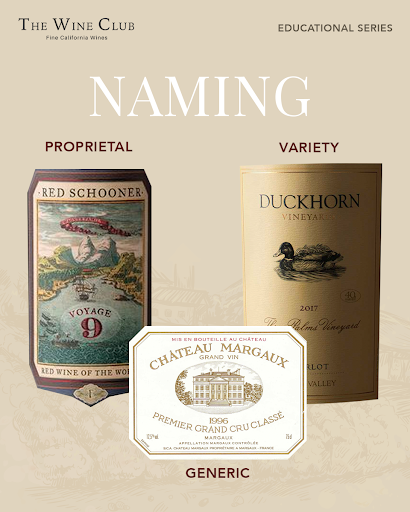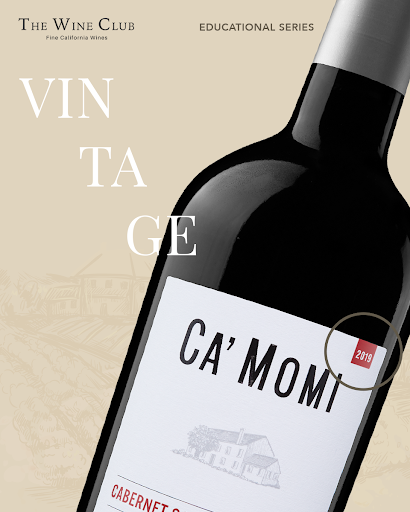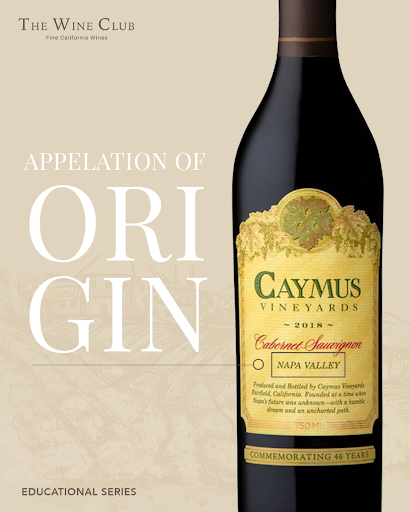The hardest part about drinking wine is reading the label. Wine producers and regulators are notorious for having nuanced labeling practices which often confuse more than clarify. In the recent decades New World producers and regulators, specifically in the US and Australia, have taken major strides in simplifying labeling practices, but there are still small details that you need to know to truly understand what is in your bottle. Today we will take a deep look at labeling California labeling rules and clarify what you need to know.

Naming
In addition to the “Brand,” there are three general naming categories for wines: varietal, generic, and proprietary. The most common name in California and New World wines in general, is the varietal. This is when a wine is named after a specific varietal, such as Merlot or Cabernet Sauvignon. This seems like common sense but is a fairly new phenomenon as it is not used to name Old World wine. In California, to have a varietal name, the wine must be composed of at least 75% of the listed varietal. The generic label, most used in the Old World, are labels using the regional name the wine was produced in (or in some New World wines case ‘inspired by’) such as Chablis or Burgundy. There is limited use of generic labels in California, but occasionally, you’ll find a California Chablis – much to the dismay of our Old-World friends. The final category is the proprietary labels which are wine names coined by winery such as Opus One or Red Schooner, Red Wine of the World. These labels are not named as a varietal or a region but a proprietary name which gives winemakers the ability to blend based on their best judgement and frees them from certain sourcing regulations.

Vintage
The vintage is the year in which the grapes are harvested – basically the wine’s age. To use a vintage on the bottle, in California, 95% of the grapes must be harvested during that year. Anything less and the wine will need to be labeled as Non-Vintage or a proprietary equivalent.
Geography
When a U.S. winery wants to show the geographical pedigree of its wine, a tag called an Appellation of Origin is used to show where the wine came from. Appellations are defined by political boundaries such as a State or County or by recognized regions called American Viticultural Areas (AVA). To be designated a ‘California’ wine 100% of the grapes used in that wine must be grown in the state and for a winery to use an appellation such as a county, like ‘Sonoma County,’ 75% or more of the wine must be harvested in that region. Even stricter, for a wine to hold an AVA designation, like the “Stags Leap District” in Napa Valley, 85% of the wine must originate from that AVA. Some wines even sport the name of the vineyard – which means that 95% of the grapes are harvested from that vineyard. Generally, the highest quality wines hold single vineyard or AVA designations while the lower quality blends hold a simple “California” designation. This is not always true, however, as some of the more interesting wines available are widespread blends that canvas the entire state.Production
Not all wine brands make their own wine! There is an expansive section of the industry that re-brands and bottles wines they do not make for different markets. So how do you know if the bottle you have is actually made by the bottler? Turn your bottle around and look for the production statement. You might see “Estate bottled” or “Grown, Produced, and Bottled by” this will mean that 100% of the grapes used must be from a vineyard that is owned or controlled within a viticultural area where the winery is located. “Produced and bottled by” designates that the bottler made, fermented, and finished at least 75% of the wine in the bottle. “Made and bottled by” means that the bottler made, fermented, and finished at least 10% of the wine. “Cellared and bottled by” indicates that the bottler has subjected the wine to cellar treatment before bottling that the stated address. “Vinted and bottled by” indicates that the bottler made less than 10% (if any) of the wine.
Knowledge of labeling rules and regulations within a certain territory will give you a better understanding of what is in your glass, how old it is, where it comes from, and who produced it. With this knowledge, you can now navigate California wine labels with confidence and show off at that next wine dinner!


